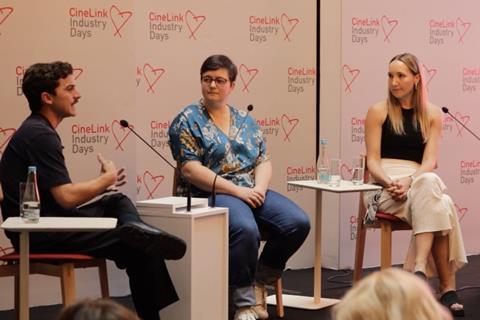How do cash-strapped indie documentary producers pay for social outreach and impact campaigns? That was one of the questions asked at Sarajevo’s CineLink Industry Days panel, “Shaping Change: Unleashing the Transformative Power of Impact Producing and Outreach in Documentary Filmmaking” this week.
The talk was held shortly after Sarajevo launched a new impact award of its own – its CineLink Impact Award presented by Think-Film Impact Production. The award comes with €20,000 of in-kind support to develop a comprehensive impact campaign for a project in the post-production phase participating in the CineLink Work-in-Progress or Docu Rough Cut Boutique.
Do producers factor the cost of these campaigns into their budgets or do they approach potential backers once the film is completed? “Starting early gives you a runway. It makes people aware the film is coming,” said Participant’s director of documentary Rory Thost.
Participant’s recent documentary titles include Mathew Heineman’s The First Wave, Steve James’s A Compassionate Spy and Laura Poitras’s Oscar-nominated Golden Lion winner All The Beauty And The Bloodshed. Thost said the Participant team is already thinking about social impact and outreach as a film is shooting.
“In documentary making, you are going to be with this thing for three, five or sometimes ten years so understanding the full scope of what you want to do, even if it changes, is advantageous,” Thost said.
Time to plan

Panellists shared insights on how social impact campaigns can transform the way audiences respond to the issues that films raise – if they are launched at the right time.
Think-Film Impact chief operating officer Amy Shepherd suggested that in some cases “a minimum of 18 months” was needed if an impact campaign was going to be effective.
Shepherd cited instances in which “impact strategy” was in place long before the film was released, for example on Alex Pritz’s National Geographic-backed The Territory, which explores the tensions between the indigenous Uru-eu-wau-wau people in the Brazilian Amazon rainforest and the settlers trying to cut down their forests and seize their land. Shepherd spoke of how Pritz and his team partnered with the World Wildlife Fund during production.
“They gave cameras to the indigenous community who then filmed themselves and became co-producers and cinematographers credited in the film.”
Community organisers associated with the film “worked at strategic levels in Europe, looking at changing legislating and [putting] indigenous rights protection into EU law.” Some key NGOs were all drafted into campaign on behalf of the film, “adding to the weight and heft” behind the project.
There young indigenous leaders were also brought to meet policy makers in Europe. This then was a film whose reach, thanks to the accompanying impact campaign, stretched far beyond the cinemas in which it was first shown.
Campaign producer
Former Participant exec Christie Marchese, now CEO of social cinema platform Kinema, pointed out that there may be less public funding for indie filmmakers in the US than Europe but there are grants they can access. These include Subject Matter, which provides resources to documentary films highlighting urgent social issues.
Marchese observed that films often include a ‘PMD’ in their budgets, that’s to say “a producer of marketing and distribution…it’s an actual line item, not just something for your campaign. Someone with that title is allowing people to raise money better.”
Noise Film & TV / NL’s Mirjam Wiekenkamp, chairing the panel, asked about the responsibilities of the producer and those of the “impact” producer.
“The reasons for hiring an impact producer are many. What is very important is that an impact producer is not a ‘producer.’ These are two very distinct roles…,” Shepherd stated. “That’s quite important…to have the recognition that the impact producer has a specific skill set, a specific expertise and is a specific focal point within the project, someone who holds all these pieces around the campaign, who holds all these relationships, who does all the strategy thinking and does outreach; who brings opportunities to the producer.”
Cost of campaigns
Marchese shared details of costs for typical impact campaigns. “The minimum to work on something is like $15,000, mostly for human time,” she said but revealed she had also seen budgets of “$1-$2 million just for the impact campaign.” She said $30,000-$50,000 was a more usual price.
Marchese warned middle-aged filmmakers that they needed to engage with Gen Z - to engage younger potential viewers and supporters through TikTok and social media. “
She also described the campaign on Kirby Dick’s 2012 doc, The Invisible War, about sexual assault in the US military. The filmmakers took the film to senior military figures in advance of the release, thereby giving extra momentum to the political debate it stirred.
Partner boundaries
Shepherd cautioned filmmakers to be wary about their partners. “They [the partners] can have their own agendas. Especially NGOs can have their own objectives and their own vision of what they want to do with your film. If you’re not on control of the impact, then you can get steamrollered.”
Shepherd also strongly advised producers “to have strategies in place so you can extricate yourself from the impact [campaign] so you don’t find yourself sucked [into] running a foundation …or running a charity that has been set up or doing a job that you didn’t imagine doing.”
“How do you put professional boundaries in place?” She asked. “How do you make sure you are taking care of yourself so your impact campaign doesn’t become all consuming? That’s something very important to consider. I’ve met many filmmakers who are so passionate about impact and are pursing it for all of the right reasons - and then find themselves down a road they don’t know how to get out of.”

























No comments yet